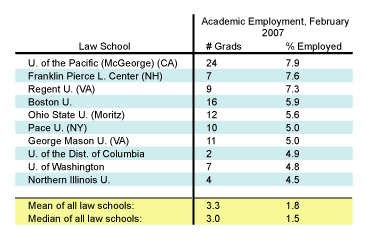
What explains these results? First off, note that "academic employment" does not here equate to teaching the law. It refers simply to working at an educational institution. Second, note that it does not equate to full-time work. Working part-time as a professor's research assistant or even as an envelope-stuffer in a law school's development office would thus qualify as "academic employment." Third, note that a school's Emp9 score counts for 14% of its score for purposes of U.S. News & World Report's law school rankings.
Together, those observations suggest a possible cause of the relatively high "academic employment" figures reported above: law schools hiring their own grads. I concede that other explanations might apply too, though. Perhaps the ABA data contains errors, for instance, or perhaps a great many graduates from, say, McGeorge got fed up with the law and became elementary school teachers. I also concede that I can imagine very good arguments for why law schools should hire their own grads for part-time work. It probably beats out-and-out unemployment.
Still, though, we might well wonder if those same graduates were sorely disappointed when they failed to find the sort of full-time legal work that they had expected to get after three years of law school. And we might well wonder how much the somewhat misleading Emp9 figures used in USN&WR's law school rankings contributed to that unpleasant surprise. Why doesn't USN&WR instead measure full-time employment for which a J.D. is required or preferred? The National Association of Legal Professionals' form [PDF], which defines the categories of employment data collected by both the ABA and USN&WR, already asks schools for that data (see question II.A.) It remains only for USN&WR to abandon the present Emp9 measure, which has proven alarmingly fallible, for something more likely to tell would-be law students what they really want to know.
[Crossposted to MoneyLaw.]
Earlier posts about Emp9 measure:
- Change to U.S. News Law School Rankings Methodology
- How U.S. News Calculates "Employment at 9 Months"
- The How, Who, and Why of Strategic Emp9 Reporting
- USN&WR to Change Employment Measure
- ABA v. USN&WR on "Employment at 9 Months" Data
- The Ethics of Strategic Emp9 Reporting
- 2008 USN&WR Law School Rankings Under New Emp9 Formula
- The Emp9 Puzzle: Answers and Questions
- Rankings Hack Hot Potato
- Hacking the New "Employment at Nine Months" Formula
No comments:
Post a Comment